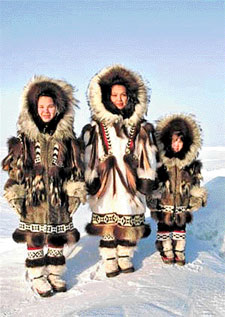|

People in the Poles
have bigger brains
People who live in high latitude regions have bigger eyeballs and
brains than other individuals, according to new research. The increase
in brain and eye size allows people to see better in places that receive
less light than areas closer to the equator, according to the new study,
published in the latest issue of the journal Royal Society Biology
Letters.

The effect is most extreme at the poles."Someone living on the Arctic
Circle would have an eyeball that is 20 per cent larger than someone
living on the equator," co-author Robin Dunbar told Discovery
News."People living at high latitudes have greater visual acuity than
those who live at the equator," added Dunbar, who is head of the
Institute of Cognitive & Evolutionary Anthropology at the University of
Oxford."The whole point is that they need to have better vision to
compensate for the lower light levels at high latitudes, as indicated by
the evidence we provide that visual acuity under ambient/natural light
conditions remains constant with latitude."
For the study, Dunbar and colleague Eiluned Pearce measured the
skulls of 55 individuals from 12 different populations, focusing on the
dimensions for orbital volume and cranial capacity. The people lived
about 200 years ago. Their skulls are now part of collections housed at
the Oxford University Museum of Natural History and the University of
Cambridge's Duckworth Collection.The researchers found significant
positive relationships between absolute latitude, orbital volume and
brain size. Eyeballs varied in size from around a quarter to a third of
an ounce in volume.
The brains, in turn, ranged from about 40.6 ounces for Micronesians,
on the low end of the size spectrum, and 50.2 ounces for Scandinavians
on the high end.Skulls from Arctic Circle residents were not included,
but the researchers made the "20 percent larger" estimate based on their
existing data.
The scientists are quick to point out that brain size isn’t
necessarily correlated with intelligence. “The point we’re trying to
make is that the larger brains of high latitude humans doesn’t mean
they're smarter, it just means they have increased the size of brain
areas dedicated to vision, and this has increased brain size overall,"
Pearce explained.
As for the larger eyeballs, they permit smaller proportions of images
to fall upon each photoreceptor field so that more details can be
distinguished.
The amount of light hitting Earth's surface as well as minimum day
length decrease with increasing absolute latitude, so people living in
such areas need the visual boost.The effect has previously been
demonstrated before in birds and other primates, but this new study is
the first to show how it affects humans.
The findings could help to explain why Neanderthals and their
ancestors may have had larger brains than us. Although possibly
technically brainier, they were not necessarily any more
intelligent.Since higher latitudes come with colder temperatures, the
researchers ruled out increases in eyeball and brain size due to more
insulating fat. Only light exposure explained the size differences, even
when climate was factored in.

The study demonstrates just how resilient and adaptable humans and
other animals can be."As we see it," Dunbar said, "populations occupying
higher latitudes have three options: keep eyes and the brain the same
and accept poorer visual acuity, increase the size of the visual areas
to keep visual acuity the same but keep brain size the same, or increase
the visual areas, but conserve the size of the frontal parts of the
brain, and do this by increasing total brain size.""It seems we have
done the third," he concluded, "since the frontal parts of the brain are
the 'smart' areas in terms of IQ. What we seem to have done is to try to
keep intelligence constant, rather than sacrificing it."
Courtesy: Discovery News |

